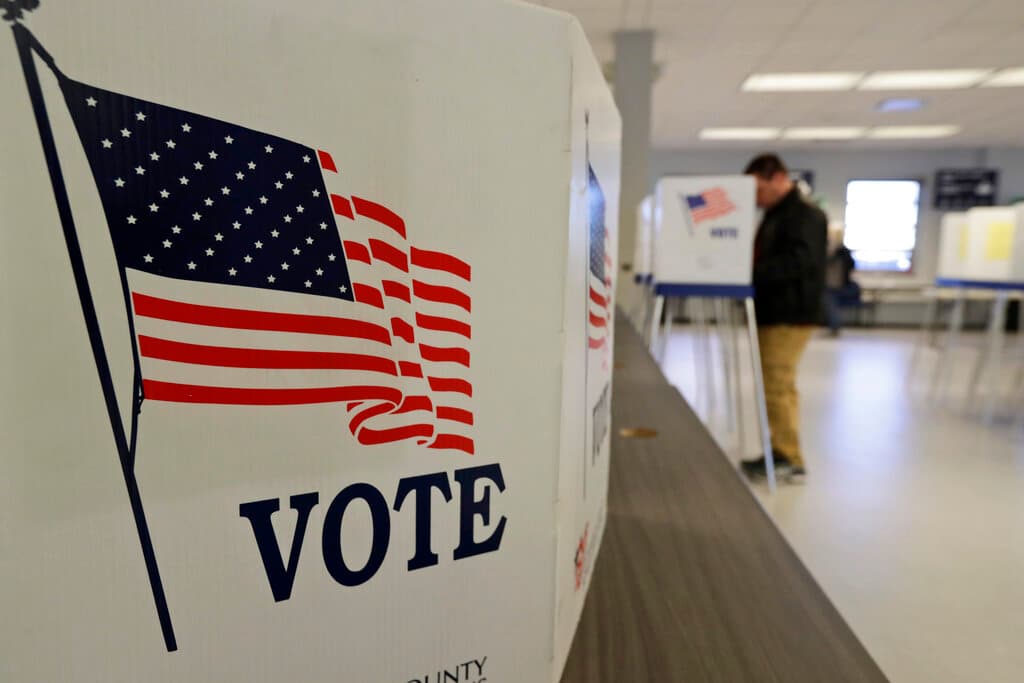Is It Third Party or Third Rail?
Given all the dissatisfaction with the Democrats and Republicans, why isn’t a strong third party emerging?

More than 60 percent of Americans are dissatisfied with both the Republican and Democratic parties and think a third political party is needed, so why isn’t a strong alternative emerging to meet the demand?
It’s hard to escape pessimism on both sides of the aisle. Trust in institutions — from big business and tech companies to public schools, the media, and the criminal justice system — has plummeted to all-time lows, according to Gallup. A scant 7 percent of Americans have “a great deal” of confidence in Congress.
“This is a moment that is ripe for political reform,” a political scientist and fellow at the New America Foundation, Lee Drutman, tells the Sun. “I think everybody believes the current system is broken.”
The Libertarian Party and the Green Party, the third and fourth largest political parties in the country, agree. Neither has ever won more than a low single-digit percentage of the vote in a presidential election. The LP’s new leadership is refocusing its energy on winning in local elections as a result.
“We’re not going to get a damn president in there. It’s all for messaging purposes. But we can and have won on the local level,” the Libertarian National Committee’s vice chairman, Joshua Smith, tells the Sun.
The Green Party is focusing on such electoral reforms as easing ballot access and adopting proportional and ranked-choice voting to make third party candidates more than so-called spoilers. “The current system has failed us,” the co-chairman of the Green Party’s steering committee, Garret Wasserman, tells the Sun.
Mr. Drutman is also pushing for electoral reforms. “Every 60 years or so we do a major rethinking of how we do democracy. It’s a familiar story in which there is a crisis, democratic institutions seem to be broken, and then the reform era follows,” he says.
Earlier this year, Mr. Drutman co-founded Fix Our House, an educational and advocacy campaign to lobby Congress to adopt proportional representation “as an urgently-needed reform to pull politics out of its doom loop of polarization and dysfunction.”
Mr. Drutman says that adopting proportional representation — a system most European democracies use, in which citizens in large districts elect multiple representatives at one time — would allow additional parties to form and gain traction as viable alternatives to the two big tents.
Mr. Drutman’s proposals are not designed to help the Greens or the LP, though they would in theory. Instead, he says we’d ideally have five or six viable political parties that could represent Americans’ diverse interests and political beliefs more thoroughly and thereby reduce hyper partisanship. In a multi-party system, one party rarely captures a majority, so party leaders must form coalitions and compromise.
Americans want more choice: 43 percent identify as independent, yet when it comes to casting a ballot they often must choose one of two parties on ideological poles. A vote for a third party is often considered a wasted vote or — worse — a lift to the opposing party. Think of the 2016 Green Party candidate Jill Stein, or Ralph Nader in 2000. Democrats blamed them for Hillary Clinton and Albert Gore’s losses.
The American system is “incredibly punishing to third parties,” Mr. Drutman contends.
A University of Maine political scientist and party scholar, Mark Brewer, agrees. He cites a political science theory, Duverger’s Law, to argue that without serious changes to our electoral system, strong third parties are unlikely to flourish. “It is very difficult to envision a single member district, first-past-the-post system that is not a two-party system,” Mr. Brewer tells the Sun.
The question is whether we are at an inflection or crisis point when Americans are ready to make substantive electoral changes. Mr. Drutman thinks so, and he points to history: the creation of primaries in the Progressive era, the 1913 ratification of the 17th Amendment, and the Voting Rights Act of the 1960s. “We have a reformist spirit in America that’s always been part of the American political tradition,” he says.
While most of the national discussion around electoral reform is centered on voter access and hyper-partisan disagreements about “election integrity” and “voter suppression,” there are recent examples of substantive electoral reforms in how candidates are elected on the state and local levels.
Through a 2020 ballot initiative, Alaska adopted a top-four primary system designed to mitigate extremism and open elections to non-affiliated candidates. Under this system, the four candidates who get the most votes move on to the general election, regardless of party affiliation or lack thereof, and ranked-choice voting determines the winner. This system may help Senator Murkowski, a moderate Republican who voted to impeach President Trump after the events of January 6, retain her seat in 2022.
New York City used ranked-choice voting for the first time in its mayoral primaries last year. Maine adopted ranked choice in 2018. Other states, including Nevada, are considering more substantive electoral reforms.
We now hear constantly that Americans are more polarized than ever, that our country is “its most divided since the Civil War.” There is even talk of a “national divorce.” The University of Virginia’s Center for Politics found that 80 percent of Biden voters and 84 percent of Trump voters view elected officials of the opposing party “as presenting a clear and present danger to American democracy.” The Nine’s recent decisions on abortion, gun rights, and climate change regulations have heightened this rhetoric.
The last time America birthed a major political party was just before the Civil War. Between the 1820s and the 1850s, in what political scientists refer to as the “second party system,” the Whigs and Democrats competed for power, until the Whig Party collapsed largely over the issue of slavery. Out of its ashes, the Republican Party arose in 1854 as the anti-slavery party, and we’ve had the Republican and Democratic duopoly ever since, with minor third parties rising and falling.
A third party could arise now from a splinter of one of the existing parties, as the Republicans did from the Whigs. There are rumblings that the Republican Party could split into pro-Trump and anti-Trump factions, Mr. Brewer says, or that a centrist party could form among anti-Trump Republicans and Democrats disillusioned by left-wing censoriousness and the progressive wing. In New Jersey, a group of independents, centrist Democrats, and Republicans frustrated by President Trump’s election fraud claims recently formed the Moderate Party, which plans to challenge the state’s ban on fusion voting in court, though the party has yet to file the lawsuit.
Splintered parties, though, do not have an auspicious history in the United States: The Whigs quickly withered after the Republican Party formed, Theodore Roosevelt’s Progressive Party failed electorally, and Southern Democrats — not quite their own party — ultimately ceded the south to Republicans.
“The rules of the game are so stacked against a third party in the United States,” Mr. Brewer says. A party that splinters would also concede power to the other side for a significant period of time. Ballot access alone is a challenge.
Mr. Brewer says ranked choice voting is not enough to give rise to a multi-party system. He and Mr. Drutman agree that without further electoral reform, a third party — moderate or not — would not last. “A single moderate party is not a solution long term,” Mr. Drutman says.
As Americans’ frustrations grow, we’re likely to see more proposed electoral reforms, though how far they go is yet unclear. Until then, expect the civil war discourse to continue.
“The people in the middle feel like nothing is working for them. The people in the extremes feel like their country is being taken away from them by people on the other side,” Mr. Drutman says.

